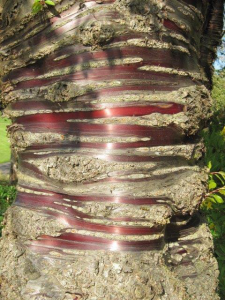
GARDENS in winter can be full of interest, a time of looking at interesting bark on trees, such as the beautiful mahogany bark of Prunus tibetica.

When walking through the Botanic Gardens, look for the different bark on eucalyptus trees and the many that peel to reveal beautiful colours underneath.
In winter we mustn’t forget indoor plants and their care. Many indoor plants prefer cooler growing conditions and can suffer from dry, overheated rooms.
It’s important to keep them away from ducted heating vents or radiators and avoid fluctuating temperatures and draughts.
As many people turn down or off heating overnight, fluctuating temperatures can cause leaf and flower drop. Ideally, indoor plants like a minimum temperature of 15C-20C.

Often indoor plants are kept near windows for light, but they can be extremely draughty. So move plants into the centre of the room and never leave them behind curtains where cold air is trapped.
Lower temperatures also reduce the need for watering and fertilising demands. Overwatering can be the death of a plant with root rot if sitting in a saucer. I suggest sitting the pot atop a saucer filled with pebbles. Discontinue feeding indoor plants in winter.
IT’S time to plant rhubarb. When planting the crowns, thoroughly mix into the soil compost or cow manure. Don’t use chemical fertilisers in the planting hole.
For an early crop after planting, cover the crowns with a layer of pea straw or similar. Place an upturned bucket over the crown to exclude light. A large flower pot can be used, but you’ll need to cover drainage holes. Check every few weeks to see the bright pink stems forming and colouring up. Pull the stems off the crown rather than cutting to avoid crown rot.
THERE’S no hurry to prune hydrangeas. It’s better to leave the flower heads on over winter to provide extra frost protection for the new buds. Pruning can be done in early spring when the worst of the frosts are over. At that time, I’ll discuss more detailed pruning methods. The dried flower heads also make great indoor flower arrangements.
IF you have a garden with neglected roses and are unsure where to start or are growing roses for the first time, the Horticultural Society’s upcoming rose-pruning demonstrations might be a help. The first is at the society’s trial garden, corner of Battye and Purdie Streets, Bruce, 1pm-3pm, on Saturday, July 15. The second will be held at 1 Spence Place, Hughes, 1pm-3pm, on Sunday, July 16.
Jottings…
- Ngaire Gamack will talk on “Barbados – the Gardens of Paradise” at the Horticultural Society’s next meeting at the Wesley Church Centre, National Circuit, Forrest, 7.30pm, on Monday, July 17. All welcome, no charge and followed by supper.
- Prune roses any time.
- Look for Daphne odora in flower at garden centres.
- Plant berry fruit, raspberries, currants, strawberries etcetera.
- Feed Hippeastrums (syn Amaryllis) fortnightly with Neutrog Seamungus to build up bulbs once the flowers fade.
Who can be trusted?
In a world of spin and confusion, there’s never been a more important time to support independent journalism in Canberra.
If you trust our work online and want to enforce the power of independent voices, I invite you to make a small contribution.
Every dollar of support is invested back into our journalism to help keep citynews.com.au strong and free.
Thank you,
Ian Meikle, editor




Leave a Reply